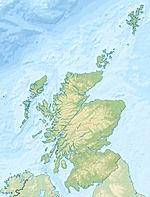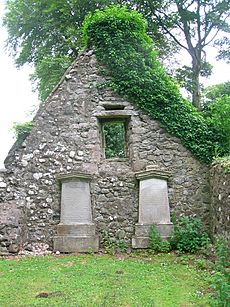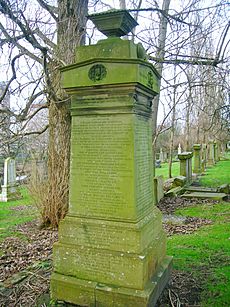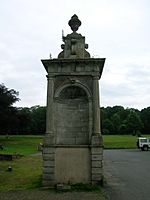Crosbie Castle and the Fullarton estate facts for kids
Quick facts for kids Crosbie Castle |
|
|---|---|
| Fullarton, Troon, South Ayrshire, Scotland UK |
|
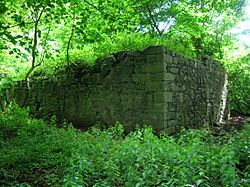
Crosbie Castle ruins
|
|
| Coordinates | 55°32′N 4°40′W / 55.54°N 4.66°W |
| Site information | |
| Owner | South Ayrshire Council |
| Controlled by | Crawford clan |
| Open to the public |
Yes |
| Condition | Ruined |
| Site history | |
| Built | 16th century |
| Built by | Crawfords |
| In use | Until 18th century |
| Materials | stone |
Crosbie Castle and the Fullarton estate are located near Troon in South Ayrshire, Scotland. For many centuries, this area was the home of the Fullarton family. The old Crosbie Castle ruins were later used as an ice house after a new mansion, Fullarton House, was built. Fullarton House was eventually taken down, and the land became a public park and golf course.
Contents
Crosbie Castle
The old Crosbie estate was given to the Fullarton family in 1344. By the 1700s, parts of the old castle were taken down and turned into an ice house for the nearby Fullarton House. An ice house was like a giant, cold cellar used to store ice and keep food fresh. There was also a dovecote (a building for pigeons) nearby. In 1969, more of the ice house was removed to make the area safe, and the dovecote was moved to ground level.
The castle was rebuilt at least three times over the years. Today, the ruins mainly show what was once the castle's strong cellar or storage area. This part of the castle had an underground stream, which made it a perfect cold storage area, like a natural refrigerator. Many of the stones from Crosbie Castle were used to build the first Fullarton House.
Some historians say Crosbie Castle is similar to Monkcastle near Dalry. There is also another Crosbie Castle or tower in West Kilbride, North Ayrshire.
Views of Crosbie Castle ruins
Crosbie Church and Cemetery
The church, located at the edge of Fullarton Park, was first mentioned in records in 1229. The building you see today dates from 1691. Local stories say that the church roof blew off and its wall was damaged on the same day in 1759 that Robert Burns was born. After that, it was left as a ruin.
The church was rarely used after 1688. One of the graves, which was recarved in the 1800s, belongs to David Hamilton of Bothwellhaugh. He was the son of James Hamilton, who was involved in the death of Regent Moray in 1570. David Hamilton is said to have died in 1619. His family lived at Overmain House, which was later called 'Fairfield'. David Fullarton had married David Hamilton's sister.
The inscription on David Hamilton's gravestone reads:
|
Heir lye corpis of ane honorabel man callt |
Another interesting gravestone belongs to Janet McFadzean, who was buried in Crosbie cemetery in 1761. Part of her tombstone reads: Here lyes the corps of Janet McFadzean, Spous of William McFadzean, Quarter-Master Sergean in Lovetenan General Homs Regiment of Sol., who died August 22, 1761, aged 27 years.
The back of her tombstone has a poem:
|
Twenty-four years i lived a maiden life, |
Carvings on a wall inside the church show that this was also the burial place for the Fullarton family, until they started using a burial plot at Irvine's Old Parish Church.
The name Crosbie comes from an old word meaning 'dwelling place of the cross'. The cemetery dates back to around 1240. It was used as the main burial ground for Troon until 1862. Even after that, some family burial plots were still used until after the First World War.
The 'Wrack Road' was a path on the Fullarton Estate. Tenants used it to take their carts to the shore to collect seaweed (or 'wrack') to use as fertilizer for their farms. It was also the main road from Troon for funerals going to Crosbie.
Views of the cemetery
A poem by John Laing suggests that Crosbie Kirk (church) has old stories of ghosts:
|
But sir, sin' I maun let you know An' comin' hame, the truth to tell, Deed Sir, I've often heard it tell, |
Fullarton House and Estate
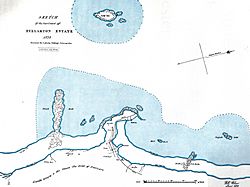

Fullarton House was built by William Fullarton in 1745. It was later changed by his son. However, the house was taken down in 1966 because the local council, who bought it in 1928, couldn't afford to keep it up. The stables, built in the 1790s, were turned into apartments in 1974.
The way to the house was changed by William Bentinck, Duke of Portland. He also changed the house design so that what was once the back became the front, offering amazing views of the Isle of Arran. The Duke of Portland bought the property in 1805. He lived there for a while, but he was more interested in developing Troon harbour and the Kilmarnock and Troon Railway.
Today, the grounds are a public park. You can still see some parts of the old estate, like the impressive stable building, decorative stone carvings, walled gardens, parts of the dovecote, and the ice house.
The Fullarton Family
The family name "Fullarton" might come from an old job called 'Fowler to the King'. This person's job was to provide wild birds for the King. The house that came with this job was called Fowlertoun, and the family might have taken that name.
The Fullarton family lived in the area for many centuries, with the family line usually passing from father to son. The family's first home was closer to the shore, but as the village grew, they decided to move about two miles east. George Foullertoun, who lived from 1430 to 1471, was often known as the Laird of Crosbie. He might have moved the family to Crosbie before Fullarton House was built.
Colonel William Fullarton, who built the house, inherited the estate in 1710. He wrote an important book in 1793 about farming in Ayrshire. He was one of the few people who praised Robert Burns's skills as a farmer. Robert Burns is said to have visited Fullarton. Napoléon III, who later became the Emperor of France, stayed at the house in 1839.
Free-traders
Colonel Fullarton's father, also named William, died in 1759 when the Colonel was only five years old. With no active owner of the estate, it might have made it easier for "free-traders" to operate. Free-traders were people who brought goods into the country without paying taxes, which was against the law. Customs officials noted that they couldn't rent property in the area because Mrs. Fullarton could make more money renting to these free-traders. Some of these houses might have had secret basements to store the hidden goods.
Views of the Fullarton grotto and stables
The Temple

This observatory, shaped like an octagon with a round roof, was located on a narrow strip of land at Troon. It was built by William Fullarton and is shown on old maps from the 1740s. It was also known as Fullarton's folly or the 'Temple on the Hill'. The area of Troon called Templehill reminds us of this structure. It was taken down to make way for a new road to the harbour.
This part of the Ayrshire coast was known for a lot of illegal trading in the 1700s. There's a story from 1767 about customs officials trying to use the Temple, but Mrs. Fullarton was away, and the servants wouldn't give them the keys.
Coal Mines
Colonel Fullarton also owned land called Bartonholm, which had several coal mines. In 1833, the coal workings accidentally broke through the bed of the River Garnock. The river water then flowed into miles of underground mine tunnels.
People tried to block the hole with clay and other materials, but it didn't work. The miners were safely brought to the surface. They watched as the river dried up for almost a mile downstream, with fish jumping everywhere. The incoming tide eventually filled the mines with water, and the river returned to normal. The huge weight of the floodwater caused compressed air to burst through the ground in many places. For about five hours, large amounts of water and sand shot into the air like fountains. The mining villages of Bartonholm, Snodgrass, Longford, and Nethermains were flooded.
In 1852, the Earl of Eglinton bought all the affected land. He dug a short canal to bypass the broken river section. Once the river course was drained and sealed, he was able to pump the water out of the flooded mines.
Parish of Fullarton
Fullarton was once a separate village and town. Because bridges were built, it has now become part of Irvine, located on the left bank of the River Irvine. The Fullarton family eventually moved to Fullarton House. From 1690 to 1823, the village officially belonged to the parish of Dundonald, but it was generally considered part of the parish of Irvine during those years.


